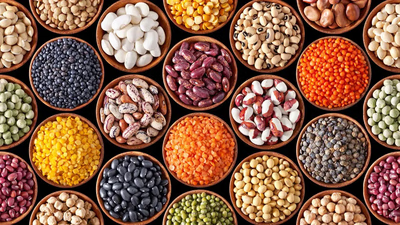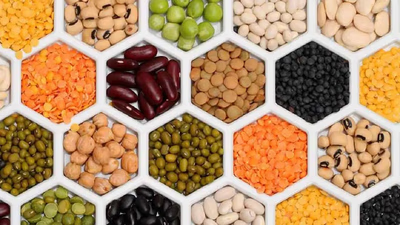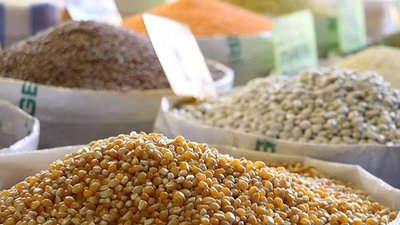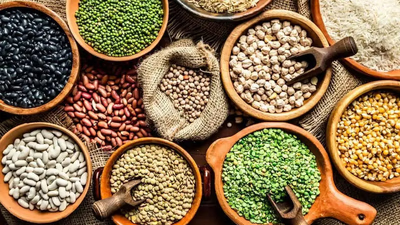
Cereals and legumes are staples in Middle Eastern cuisine.
Grains and legumes are indispensable components of West Asian diets, offering versatility, nutrition, and a strong connection to cultural heritage. From the ubiquitous pita bread to the comforting ful medames, these foods form the foundation of the culinary identity of the region, reflecting both its history and the diversity of flavors and traditions found within. Grains and legumes play a central role in the culinary traditions of West Asia, which encompasses the Middle East. These ingredients serve as the backbone of many traditional diets, and their significance can be explored in detail.
One of the primary grains used in West Asian cuisine is wheat. It is predominantly utilized in the making of various types of bread, which are staples in the region. The most common varieties include pita, a soft and round flatbread with a pocket that is perfect for stuffing with meats, vegetables, and hummus. Another type is lavash, a thin and soft flatbread that can be rolled or folded. Additionally, khobz, a generic term for bread in Arabic-speaking countries, refers to a basic flatbread. Bulgur, a parboiled cracked wheat, is another wheat-based ingredient used in dishes like tabbouleh, a salad with parsley, tomatoes, and onions, and kibbeh, a dish made from bulgur and minced meat.
Grains and legumes are not only nutritionally significant but also deeply ingrained in the cultural and social fabric of West Asian societies. They are not only consumed as daily staples but also hold a prominent position during festive and religious occasions. These foods provide essential nutrients, including proteins, fibers, vitamins, and minerals, making them vital for a balanced diet, particularly in regions where meat may not always be readily available or affordable. Grains and legumes play a central role in the culinary traditions of West Asia, which encompasses the Middle East. These ingredients serve as the backbone of many traditional diets, and their significance can be explored in detail.
Cereals and legumes are very important in the lives of Middle Eastern people and are considered as an important part of their diet. Cereals and legumes, especially rice, wheat, barley and chickpeas, are the main source of energy for people in the Middle East. These foods contain carbohydrates that act as fuel for the body and provide the necessary energy to perform daily activities. Legumes have a special place in the Middle East diet as cheap and rich sources of protein. The people of West Asia, especially in countries like Iran, Iraq, Turkey and Lebanon, use grains and legumes a lot in preparing their traditional foods.
- Qorme Sabzi : This dish is prepared using legumes such as green beans and tarrikhina (a type of legume) and various vegetables such as leeks, fenugreek and parsley. Qorme Sabzai is one of the most popular dishes in Iran .
- Lentil rice : This dish is prepared using lentils, rice and various spices such as turmeric, cinnamon and cardamom. Lentil pilaf is a traditional Iranian dish that is usually garnished with meat and dried fruits, such as blackberries or plums.
- Dal : Dal is a type of legume that is widely used in Middle Eastern and Indian cooking. A mixture of chickpeas, lentils, beans and lentils can be used in the preparation of dal dishes. Dal dishes are usually prepared with spices and vegetables such as onion, garlic and ginger.
- Rice with Beans : This dish is prepared using rice, red beans and various spices such as saffron and cinnamon. Plow with beans is one of the famous dishes in Iran, which is usually served with meat or chicken.
- Kufte : This dish is prepared using minced meat and legumes such as peas or lentils. Meatballs are usually served with tomato sauce and various spices and are popular as a main dish in many West Asian countries.
These are just a few examples of traditional foods of West Asian people with grains and legumes. Every other country and region also has special foods with different grains and legumes. Cereals and legumes can be the main food of people in the Middle East, especially in conditions of poverty and low income levels. Cereals and legumes, due to their relatively low price and easy access, are considered as economic food sources for the people of the Middle East. They can be the cheapest source of protein, fiber, vitamins and minerals in food. Cereals and legumes have a lot of fiber, protein, vitamins and minerals. Consuming these foods can help to eat healthy and meet people's nutritional needs. Many countries in the Middle East have the ability to produce grains and legumes. These food resources can be used as a local base to meet people's food needs and reduce dependence on food imports.
Rice is also a staple grain in West Asian cuisine and is often featured in elaborate dishes. Pilaf or pilav is a popular preparation where rice is cooked with broth and spices, sometimes accompanied by meat, vegetables, or nuts. Mujaddara is another dish that combines rice with lentils and caramelized onions. Stuffed vegetables, such as peppers, zucchinis, and grape leaves, are commonly filled with a mixture of rice, ground meat, and spices, resulting in dishes like dolma or mahshi. Turning to legumes, chickpeas hold a prominent place. They are widely used in various forms, such as hummus, a popular dip made from mashed chickpeas, tahini, olive oil, lemon juice, and garlic. Falafel, deep-fried balls or patties made from ground chickpeas, is often served in pita bread with vegetables and sauces. Chickpeas are also incorporated into stews and soups, providing a hearty and nutritious component to these dishes.
Lentils are another essential legume in West Asian cuisine. They are frequently used in lentil soup, a common and comforting dish seasoned with cumin, coriander, and other spices. As mentioned earlier, lentils are combined with rice in mujaddara, a staple dish in many households. Additionally, cooked lentils are often added to salads or served as a side dish, contributing to the overall diversity of flavors and textures. Among the legumes, fava beans hold a special place. Ful medames, a traditional Egyptian dish, is made from cooked and mashed fava beans, typically seasoned with olive oil, lemon juice, garlic, and spices. Bissara is another preparation featuring a puree of fava beans, which can be served as a dip or soup, adding a unique taste to the culinary repertoire.



